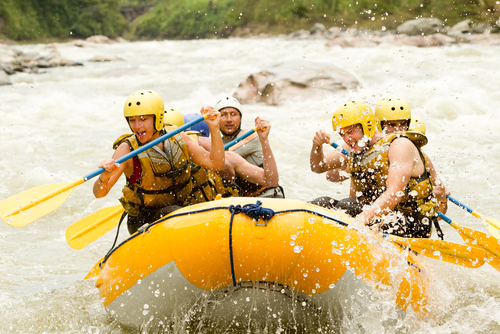Whitewater rafting gets wild on Idaho’s Salmon River
Attack it. Commit. Stay strong paddling through it. We’ll meet you below,” river guide John Hillman instructs our teenage son, Will, over the roar of whitewater pounding through protruding jagged boulders. Wedged in an inflatable single-person kayak, Will is about to navigate his first Class IV rapid.
Our rubber boat jolts forward, leaving Will behind. I’m paddling air as we drop into crashing waves. A cold, green wall slams and soaks us before we reach the eddy’s slackened water at the bottom of Idaho’s Tappan Falls.
I’m panting more from parental fear than paddling. Will’s dad and I crane our necks to watch our son’s lone descent. His red helmeted-head pops above pummeling white water and disappears. Then, he bursts from the misty, roiling maul howling with joy.
Because of its free-flowing, 104 miles of more than 100 Class III through IV rapids, professional river runners consider central Idaho’s Middle Fork of the Salmon River a premier destination among the nation’s Wild and Scenic Rivers System, established 50 years ago to preserve and enhance free-flowing areas. No dams block the Middle Fork’s unfettered run through the 2.3 million-acre Frank Church River of No Return Wilderness, some of the most rugged and remote territory in the Lower 48.
Cellphone signals and Wi-Fi don’t connect here, so families engage in face time charged only by our shared adventure.
“When you’re in pure wilderness, you must take care of each other because this is the real world,” says Nick Grimes, who, like Hillman, is a guide with the California-based whitewater rafting outfitter OARS.
“This is the best trip my son Daniel and I have ever done being truly away from civilization, enjoying our group’s comraderie and his kayaking,” says Scott Israel from Portland, Ore.
During our six-day, OARS Middle Fork trip, melodious birdsong wakes us to eat a hot breakfast, break camp and pick our boat — paddle, passenger or kayak — for the day. Lunch stops of burrito wraps and fresh fruit include optional, guide-led hikes. We journey to a windswept ridge to view the dense Salmon-Challis National Forest, and also see a 100-year-old Tappan homestead cabin and swaths of barren mountainside blackened by fires ignited by lightning. Atop tumbling Veil Falls, panoramic, twisting river vistas unfold. Below Redside Rapids, pictographs drawn by Sheepeater Indians centuries ago adorn canyon walls.
“River trips are great equalizers that break down barriers to forge a group of strangers into a cooperative, nomadic village traveling downstream,” says OARS trip leader and guide Ashley Brown.
Our floating tribe pitches camps along the riverbank shaded by towering Ponderosa Pines Scenic Byway. We share tales around blazing campfires until embers die. Near Big Loon Camp, we soak tired muscles in hot springs before enjoying the guide-prepared dinner of barbecue chicken, peppery cabbage salad and baked Idaho potatoes, accompanied by Columbia Valley wines. The setting sun silhouettes our group’s fly-fishers casting for native cutthroat and rainbow trout. As guides strum guitars, a distant thunderstorm performs some natural pyrotechnics. At Survey Camp, we watch bighorn sheep graze close by, leaving half-moon tracks like quotation marks punctuating the sand. Will says, “It doesn’t get more real than this.”
On the river, talk flows as easily as our raft glides over rocks submerged in gin-clear water. We learn about local hermit Earl Parrott and wonder whether Bigfoot roams this austere wilderness. But chat of sasquatch stops upon entering Impassable Canyon. Blue sky slivers between sheer, narrowing granite walls. Temperatures drop. The river grumbles, then rages through Hancock Rapids’ vertical rock garden.
Wet reality slaps me hard in the face. The rapid’s spit disguises my tears of awe, gratitude and sadness that our adventure will end around the bend where the Middle Fork meets the Main Salmon River. We’ll lay our paddles down, but I won’t pick up my phone. I want to remain in thought about the river trip that connected us.

